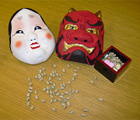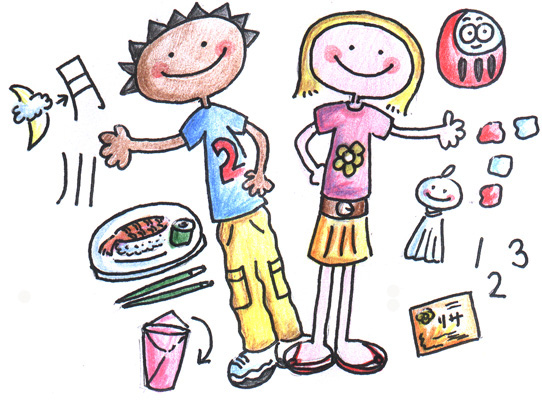Lesson 9
Lesson Plan Download pdf
Main (25 minutes)
Explain to the children that setsubun is an ancient festival, celebrated on the 3rd or 4th February in Japan. It marks a new start and the beginning of spring. It is a time when new seeds are planted and things begin to grow. It used to be that setsubun marked the beginning of spring and there actually used to be four setsubun festivals, each one marking the change of the seasons. Now only the spring festival is celebrated.
The most common way to celebrate setsubun is by doing mame maki (bean throwing). One member of the family (usually a man) will dress up as a devil (oni) and the rest of the family will throw dry fried soya beans at him whilst shouting, “Oni wa soto, fuku wa uchi!” This roughly translates as, “Demons out, good luck in!”
Each person then picks up the number of beans corresponding to their age and eats them (to bring good luck for the year ahead). Many people will also hang sardine heads and holly leaves on the door of their houses. This is supposed to keep the demons away.
Read the following tale to the class, stopping at various points to check understanding. Use the cut out character flashcards to help illustrate the story - you could have children come up to the front and act out the story as you tell it, using the characters as props.
Once upon a time there lived a farmer who had a very beautiful daughter. All the boys in the village wanted to marry her. But the farmer said to the boys, “If any of you can lift the millstone with his bare hands, you can marry my daughter!” The millstone was huge and very heavy. Nobody could lift it.
One day, a young man turned up at the farmer’s house. His arms were as thick as tree trunks and his body looked strong and sturdy. He said to the farmer, “Is it true that if I can pick up the millstone, you will give me your daughter?” The farmer replied, “Yes, that’s right.”
So the boy wrapped his arms around the millstone, gave a great roar and lifted the millstone right above his head. The farmer and the rest of his family stood with their mouths open, shocked.
“Now you must give me your daughter as you promised,” said the young man. And he quickly hoisted her over his shoulder and ran off into the mountains.
“Wait!” shouted the farmer. “Who are you? Where are you from?” He was shocked and worried. In a panic he chased after the young man and his daughter.
On and on they ran, deep into the mountains. The farmer followed them and saw them reach a light in the distance. The young man took his daughter inside.
The farmer crept up behind them, and saw that they had reached a demons’ lair. The demons were right in the middle of a big party and the farmer’s daughter was sitting next to a young demon.
“Ah! that must be the young man who lifted the millstone,” the farmer whispered to himself. “But he’s really a demon!”
Although the farmer was very scared he was even more worried about his daughter, so he stayed to see what would happen.
Eventually the demons got drunk and began to sing: “Yaa, yareyo! Better not go near sardine heads or your nose will shrivel and fall off! Better not go near holly leaves or they’ll scratch your eyes and make you blind! Yaa, yaa, yareyo!”
The demons clapped in time to the beat, accompanying their song. The farmer listened carefully to the words of the song.
One of the demons now turned to the farmer’s daughter and yelled, “Hey, now you must sing for us!” ”That’s right,” said another, “Sing! sing!” So the girl sang a song in a most beautiful voice.
“Now it’s time for the flies and mice to sleep. Now it’s time for the cows and horses to sleep. Now it’s time for you, child, to sleep, goodnight.”
The demons listened, entranced, completely absorbed in her song. One by one, they began to doze off, right where they sat. Before long, all you could hear were huge snores. All the demons had fallen asleep. The farmer quickly ran to his daughter. “Now we can escape!”
The girl said, “Look, this iron club is called a senriba. If you tap it once it will take you anywhere you want. Let’s use it to escape.” The farmer and his daughter sat astride the senriba and gave it a quick tap.
In an instant they were back at home. They told everyone what had happened, that they had just run away from the demons’ lair. Everyone was very worried about what the demons would do when they woke and found the girl gone.
“Don’t worry,” said the farmer, “I know what demons are afraid of. Quick, get a holly leaf, stick a sardine head on top and hang it outside over the doorway.” The grandmother added, “Let’s get some soya beans too. People say that they ward off evil”.
Before long they could hear footsteps: DOKA DOKA, GARA GARA. The demons were on their way back to get revenge.
“Where’s the girl?” one of the demons shouted. “Give me back my wife!” yelled another. “If you don’t give her back I will twist you and crush you to bits!” shouted another. The demons ran towards the doorway, but then they saw the sardine and the holly.
“Pooh, what a stink!” said one. “Yuck! A sardine head” shouted another. “Ouch! Holly leaves,” said another. “It’s got me in the eye! I can’t see!” The demons couldn’t get past the doorway.
“Now it’s our turn,” said the farmer. The farmer and his family started to throw beans at the demons. “Ouch! ouch” cried one. “Oh no they’ve got beans - scary!” shouted another demon. The demons panicked as they were hit by some beans and slipped on others. “Let’s run away!” “We are no match for the beans!” Crying and screaming, the demons ran away and the family had a quiet life again.
Activity:
Have the children make their own oni (demon) masks. You could either
use the template provided (and simply mount on to card before threading
string/ elastic through the back), or children could examine various
different Japanese masks before designing their own. The following website has some good pictures of Japanese Noh drama and other masks which could be used as a basis for their research:
https://www.prm.ox.ac.uk/conservation-case-study-noh-theatre-masks/
Visit the Japan Society setsubun resource page for additional resources, activity ideas and templates: https://www.japansociety.org.uk/resource?resource=7

Once the masks are completed, you could even have your own mini setsubun festival and children could try using chopsticks to pick up the number of beans (or pasta shapes) which correspond to their age. Have them count out their beans in Japanese!
Note: beans should not be eaten without parental consent. In Japan, special cooked setsubun beans are sold. Do not try eating dried soya beans sold in the UK.
